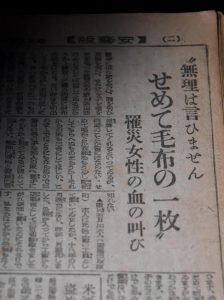Documenting Hiroshima of 1946: January 30, cries of women who had lost husbands
Jan. 30, 2025
by Minami Yamashita, Staff Writer
On January 30, 1946, the Chugoku Shimbun published an article under the headline “Blood-curdling cries of women victims of A-bombing.” The article featured the voices of two women who had lost their husbands in the atomic bombing or on the battlefield. Having lost the family breadwinners with young children to care for, the women were struggling amid soaring prices and food shortages.
One woman, from the area of Misasa-honmachi (in Hiroshima’s present-day Nishi Ward), lost her husband, who had run an ironworks factory in the Sakan-cho area (in the city’s Naka Ward), as well as her mother and oldest daughter in the bombing. In September, she experienced the Makurazaki Typhoon in the outskirts of the city, where she had evacuated, leaving her penniless and living in a shack with her five children.
Lacking sufficient bedding and clothing, the children shivered from the cold. Food was too expensive for her to afford. She said in the article, “My entire life right now feels like a constant rush, consumed by the daily worry about finding food.” With no income, she even considered putting her third son up for adoption.
The other woman’s husband was killed in the war. Left to care for her small child alone, she felt lost and desperately hoped for government support. She said, “I would never ask for anything extravagant. Could they just help me get by, even if just day to day?”
Akira Takeuchi, now 91, a resident of Hiroshima’s Nishi Ward, was a first-year student at Hiroshima Prefectural Hiroshima Commercial School (today’s Hiroshima Prefectural Hiroshima Commercial High School) at the time. He also had lost his father, Hide, then 45, around one month after the bombing. The stone powder manufacturing factory his father had operated in the area of Higashikanon-machi as well as their house had burned to the ground in the bombing. His mother, Miwako, then 41, who passed away in 1976 at the age of 73, had taken refuge in her hometown of the village of Konu (in present-day Miyoshi City) with his two younger brothers.
Mr. Takeuchi commuted to school in the Eba-machi area (in Hiroshima’s present-day Naka Ward) from a relative’s home in the Rakurakuen region (in the city’s Saeki Ward). On holidays, he would visit Konu village, where he received clothes from his cousins to keep warm and ate white rice, something he usually could not afford. He said, “I just wanted to wear warm clothes. Normally, I would be a bit lucky to eat Eba dango dumplings.”
With support from his relatives, he built a shack in 1947 where their house had once stood and began living there with his family of four. He recalled, “My mother never said anything about it, but I think she must have had a hard time raising three boys.”
(Originally published on January 30, 2025)
On January 30, 1946, the Chugoku Shimbun published an article under the headline “Blood-curdling cries of women victims of A-bombing.” The article featured the voices of two women who had lost their husbands in the atomic bombing or on the battlefield. Having lost the family breadwinners with young children to care for, the women were struggling amid soaring prices and food shortages.
One woman, from the area of Misasa-honmachi (in Hiroshima’s present-day Nishi Ward), lost her husband, who had run an ironworks factory in the Sakan-cho area (in the city’s Naka Ward), as well as her mother and oldest daughter in the bombing. In September, she experienced the Makurazaki Typhoon in the outskirts of the city, where she had evacuated, leaving her penniless and living in a shack with her five children.
Lacking sufficient bedding and clothing, the children shivered from the cold. Food was too expensive for her to afford. She said in the article, “My entire life right now feels like a constant rush, consumed by the daily worry about finding food.” With no income, she even considered putting her third son up for adoption.
The other woman’s husband was killed in the war. Left to care for her small child alone, she felt lost and desperately hoped for government support. She said, “I would never ask for anything extravagant. Could they just help me get by, even if just day to day?”
Akira Takeuchi, now 91, a resident of Hiroshima’s Nishi Ward, was a first-year student at Hiroshima Prefectural Hiroshima Commercial School (today’s Hiroshima Prefectural Hiroshima Commercial High School) at the time. He also had lost his father, Hide, then 45, around one month after the bombing. The stone powder manufacturing factory his father had operated in the area of Higashikanon-machi as well as their house had burned to the ground in the bombing. His mother, Miwako, then 41, who passed away in 1976 at the age of 73, had taken refuge in her hometown of the village of Konu (in present-day Miyoshi City) with his two younger brothers.
Mr. Takeuchi commuted to school in the Eba-machi area (in Hiroshima’s present-day Naka Ward) from a relative’s home in the Rakurakuen region (in the city’s Saeki Ward). On holidays, he would visit Konu village, where he received clothes from his cousins to keep warm and ate white rice, something he usually could not afford. He said, “I just wanted to wear warm clothes. Normally, I would be a bit lucky to eat Eba dango dumplings.”
With support from his relatives, he built a shack in 1947 where their house had once stood and began living there with his family of four. He recalled, “My mother never said anything about it, but I think she must have had a hard time raising three boys.”
(Originally published on January 30, 2025)








